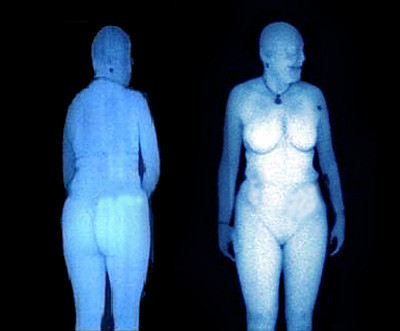Body scanners cause cancer? Well maybe

I was in Canada this week and on my way back to New York through the Ottawa airport I chose to be body scanned. Something had triggered the metal detector. Maybe the underwire in my bra they guessed. So security offered, “Pat down or scan?” I chose scan because I was in a rush and pat downs take a lot of time. Up to 15 minutes sometimes. It's easy to be scanned. But every time I’ve been scanned (three times) I feel uneasy.
ProPublica’s ongoing investigation of scanners in the U.S. provides some answers to common worries.
The Transportation Security Administration (TSA) plans to install body scanners at every security check lane by 2014. And the TSA confirms that the scanners pose “no health or safety risk for any passenger.” They’ve apparently been cleared by the Food and Drug Administration and they’ve been used for years in airports around the world. (I went through my first in Canada in 2009.)
But there have been cancer concerns with the scanner that uses X-rays.
In independent, peer-reviewed studies, radiation experts concluded that the X-ray scanner could cause six to 100 airline passengers each year to develop cancer. Outside the United States, few countries use X-ray imaging machines, also known as backscatters, in their airports. And the FDA has no authority to approve body scanners before they are sold because they are electronic products, not medical devices.
Just this past November the European Union decided to prohibit X-ray body scanners in all European airports. Now members of Congress are asking the TSA to do an independent safety review.
Right now the TSA uses two types of scanners, the millimeter-wave machine and the backscatter X-ray machine. ProPublica dissects the two here.
The millimeter wave machine, below, sends radio frequency waves over your body and the energy reflected back is analyzed for suspicious items.
To address the controversy of the "virtual strip search" the TSA only uses a generic unisex image that looks like a cartoon outline of a human, see image at left below.
There are no known health risks with a millimeter wave machine. Currently, there are about 300 of them in U.S. airports, including major hubs like Atlanta, Dallas-Fort Worth and San Francisco. The U.S. uses the L-3 Communications’ ProVision scanner that runs about $170,000 to $180,000.
The backscatter machine (below) emits a low intensity X-ray beam over the body. Now these rays do not go through the body like your typical medical X-rays, but rather the rays are reflected back to detectors that then create a low resolution, whitish 2D image (also below.)
After being cleared the images are deleted. According to the TSA each scan gives off less than 10 microREM of radiation, equivalent to the radiation we are subjected to when we fly at 30,000 feet for three minutes. This appears to contradict the statement above regarding studies that found six to 100 people could develop cancer from these machines. I imagine there are a lot of variables (existing health of the passenger for one) that need to be accounted for in performing accurate studies. Just living in New York City, for instance, increases my chances of getting breast cancer. These machines need to be compared to other sources of radiation that we are all exposed to daily in cities.
But rightly so, people have asked why the TSA chooses to use the backscatter as opposed to just the millimeter wave machines. From ProPublica:
The TSA has said that keeping both technologies in play encourages the manufacturers to improve detection capability while lowering the cost for the taxpayer. The agency says the X-ray machine is safe because the radiation is equivalent to the amount passengers receive in two minutes of flying at altitude.
But ProPublica found some potential problems with the millimeter-wave scanner. Several other countries have reported a high rate of false alarms caused by innocuous things, such as folds in clothing, buttons and even sweat.
There are about 250 X-ray scanners (Rapiscan’s Secure 1000 scanner) in U.S. airports. It’s in hubs like Los Angeles, Chicago O'Hare and New York’s John F. Kennedy. It costs about $170,000 to $180,000.
In terms of effectiveness, well that has yet to be seen. Apparently studies have suggested that scanners could miss plastic explosives similar to the one used by the “Underwear Bomber” in 2009. The Department of Homeland Security is evaluating how accurately the TSA is monitoring the radiation of the backscatters and the Government Accountability Office is investigating the detection accuracy of both machines.
By the way, the security officers in the Ottawa airport never did confirm what set off the initial trigger that led me to be scanned.
[via ProPublica]
[Photo publik16]
Related on Smart Planet:
- Dishonesty detectors: a criminally flawed technology
- Next? Body scanners could be on trains, subways and boats
- Why the leaked body scanner photos matter
This post was originally published on Smartplanet.com




